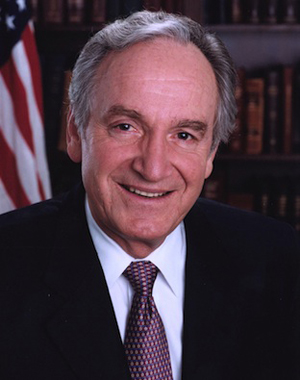There are many critics of for-profit colleges and universities.
Probably the most prominent critic is U.S. Sen. Tom Harkin, a Democrat from Iowa.
Harkin has several specific concerns about for-profits, but his overriding problem with the industry is that, in his view, for-profit schools care more about making money than educating students.
"They're on the hook to Wall Street," he says.
Harkin chairs the Senate's Health, Education, Labor and Pensions Committee (HELP). Between June 2010 and July 2012, the HELP Committee conducted an investigation of the for-profit higher education industry that included a number of high-profile hearings on Capitol Hill, several scathing reports by Harkin's staff and the Government Accountability Office, and a final report that is 5,234 pages long.
Harkin is particularly critical of the University of Phoenix. He thinks when the school was founded in 1976 it had a "pretty good model." Back then, Phoenix students had to have two years of college credit already, they had to have work experience, and they had to be at least 23 years old.
"They started out as a college completion school," says Harkin. Many of the students were successful. But then the school "kept expanding and expanding and expanding, and so it kind of morphed into this behemoth that it is now," he says.
The University of Phoenix is the nation's largest private university. Its enrollment peaked in 2010 with 470,800 students, more than in all the universities of the Big Ten Conference combined. But according to the HELP investigation, more than 60 percent of the students who started degrees at the University of Phoenix in 2008-2009 ended up leaving by the middle of 2010 without a degree. The students who quit had been enrolled for a median of four months.
Harkin believes the University of Phoenix went wrong in 1994 when it became a publicly traded company.
"I think what really turned this company is when they started going to Wall Street," he says. "[They] started raising hedge fund money, and then they had to meet quarterly reports, and all they were interested in, basically, was 'How much money ya makin'?'"
The Role of Wall Street
Students have been going to for-profit colleges for a long time. One of the oldest for-profits is Strayer University, founded in 1892 in Baltimore as a business college. For decades Strayer operated as a small, regional school offering training in skills such as shorthand, typing and accounting. Some of the first students were farm workers looking for new ways to make a living.
In 1996, Strayer College established Strayer Education, Inc. and went to Wall Street to raise capital for expansion. At the time, several other for-profit schools were going public, too; the University of Phoenix had done so two years earlier.
Wall Street capital allowed schools like Phoenix and Strayer to get much bigger. Strayer went from having fewer than 10,000 students in 1996 to more than 60,000 students by 2010. Phoenix grew from about 10,000 students to more than 100,000 students in the five years after it went public -- and then nearly quintupled in size over the next decade.
By 2010, about 10 percent of all U.S. college students were attending for-profit schools. Close to 80 percent of those students were enrolled at schools owned by publicly traded companies or private equity firms.
Harkin thinks this is a problem. For-profit companies are ultimately accountable to shareholders and investors. To stay in business, they must produce returns. Harkin's investigation found that publicly traded companies operating for-profit colleges had an average profit margin of 19.7 percent. In 2009, the Apollo Group -- the company that owns University of Phoenix -- allocated 27 percent of its revenue to profit, according to Harkin's investigation.
It's hard to compare that figure to public and nonprofit colleges and universities because those schools don't make "profit," though they certainly generate lots of revenue through tuition, grants and other sources. Harkin's committee compared the amount of money spent on student instruction by different kinds of colleges. In fiscal year 2009, the 30 for-profit education companies examined by the HELP committee spent 17.7 percent of all revenue on student instruction. On average, the companies spent $2,050 per student. Apollo -- the University of Phoenix parent company -- spent $892 per student according to the committee's analysis.
The HELP committee did not come up with a corresponding average for public or nonprofit colleges, but it compared each for-profit school to nearby "traditional" colleges -- a community college, a state university and a private nonprofit college. The committee found that the traditional schools it compared to the University of Phoenix spent between $3,344 and $11,128 per student on instruction.
Harkin wants the University of Phoenix and other for-profits to put more of the money they take in toward student instruction, and less toward marketing, recruiting and executive pay.
Executive Pay
Executives and presidents at for-profit colleges and universities are typically better paid than their peers at nonprofit institutions, both public and private.
According to the HELP committee, the CEOs of publicly traded for-profit higher education companies took home, on average, $7.3 million in 2009. Those pay packages typically include stocks, options and bonuses; the value of an executive's pay changes depending on the company's and the executive's performance.
In contrast to the for-profit industry, the five highest-paid leaders of large public universities averaged total compensation of $1 million, according to the HELP committee. At private, nonprofit schools, the five highest-paid leaders averaged total compensation of $3 million a year.
According to Securities and Exchange Commission filings, University of Phoenix founder John Sperling, who is chairman of the board of the Phoenix parent company, Apollo Group, received total compensation of $8.6 million in 2009. The next-highest-paid executive, Apollo Group president Joseph D'Amico, earned total compensation of $5.1 million. Other top executives earned between $1.6 and $2.3 million in 2009.
The highest-paid president of a public university in 2009 was E. Gordon Gee of Ohio State. Gee earned $1.3 million in total compensation, according to the Chronicle of Higher Education. Many college football coaches are paid even better. An analysis by USA Today found that 37 football coaches made more than $2 million in 2009. Most of those coaches work at public universities.
Marketing
The University of Phoenix has a vast and sophisticated marketing and recruiting operation. In 2011 the Phoenix parent company, Apollo Group, spent more than $1 billion on recruiting and marketing -- about 23 percent of the company's revenue.
The company will not say how many recruiters it employs, but Harkin's committee found that the 30 for-profit companies it investigated employed, on average, one recruiter for every 48 students.
The University of Phoenix does not have any employees it calls "recruiters." They are called enrollment advisers. Some of those enrollment advisers are based at University of Phoenix locations around the country, where they often meet with prospective students face to face. But many of the advisers are located in Phoenix, where they work in big rooms that look and sound like call centers.
At the company's headquarters, a collection of modest office buildings near the Phoenix airport, about 700 advisers work in two buildings -- and that's just to service online students in the central United States. Some of the advisers focus specifically on enrollment. Other advisers specialize in financial aid or academics. Every student who enrolls at Phoenix now gets one of each kind of adviser; the company calls this a "graduation team."
The advisers sit at cubicles decorated with pictures of their families as well as University of Phoenix pins and bumper stickers and, in some cases, grateful letters from students they have worked with. Advisers spend most of their day on the phone. They help prospective students figure out what degree they want, fill out financial aid forms, and gather the paperwork needed for a transcript review of previous college credits.
The University of Phoenix says these advisers make the complex process of signing up for college and applying for financial aid simpler and more user friendly.
But Bob Shireman, former deputy undersecretary of education in the Barack Obama administration, says Phoenix and other for-profit colleges make college too easy to buy.
"They get the train moving down the track, and the next thing you know you're signed up for the program," says Shireman. "You've taken out a federal loan, and it's happened, sort of like buying something at the checkout stand at the store. You didn't totally plan it, but you kind of had a little bit of interest and next thing you know, you're a student."
Shireman is particularly concerned about low-income and first-generation college students, who may not know much about how college works and may not understand that even if all of their tuition is covered by federal aid, they will have to pay back the money that comes from loans -- whether they finish their degree or not.
Virtually all (96 percent) of the students who go to for-profit schools borrow money. By comparison, 13 percent of students at community colleges, 48 percent at four-year public schools and 57 percent at four-year private nonprofit colleges borrow to pay tuition.
There are several reasons for this. Tuition is typically higher at for-profits than at public schools -- in part because when a student goes to a public school, state taxpayers are footing some of the bill, lowering the tuition price. Private nonprofit colleges often reduce the sticker price for students through scholarships and other kinds of institutional aid. And students who go to for-profit schools are more likely to be low-income than students at other kinds of colleges. They have to borrow to pay tuition.
Bob Shireman is concerned that students who go to for-profit schools don't realize they might be able to go to public colleges, where they'd typically pay less. He says the extensive marketing by for-profits -- slick TV ads and abundant Internet pop-ups -- overwhelms the marketplace and crowds out public schools that don't, or can't, spend millions of dollars a year on marketing.
Shireman and other critics of for-profits are also concerned that some schools use aggressive or misleading tactics to get students to sign up. There is evidence that some schools, including Phoenix, did this, at least in the past.
A 2007 University of Phoenix training manual obtained by the Senate HELP committee instructed recruiters to push prospective students to enroll by creating a sense of urgency. You have "to challenge [students] to act NOW," the manual said.
Another training document stated: "Do not tell the student we have classes running every week unless you can agree on a start date." To create urgency, recruiters were instructed to avoid telling prospective students, "[Y]ou have plenty of time to get everything in order," because "if the student thinks he/she has plenty of time, he/she might wait and apply later."
The company told the HELP committee that the training manual is no longer in use. (Read the University of Phoenix/Apollo Group response to the HELP committee investigation.)
According to the committee's final report, "[M]any companies used tactics that misled prospective students with regard to the cost of the program, the availability and obligations of financial aid, the time to complete the program, the completion rates of other students, the job placement rate of other students, the transferability of the credit, or the reputation and accreditation of the school."
Another concern is how enrollment advisers were managed and paid. The HELP committee found that in order to achieve company enrollment goals, recruiting managers at some companies "created a boiler-room atmosphere, in which hitting an enrollment quota was recruiters' highest priority. Recruiters who failed to bring in enough students were put through disciplinary processes and sometimes terminated."
Some companies paid recruiters based on how many students they enrolled. This kind of "incentive compensation" has a long and somewhat complicated history.
Back in 1992, in response to evidence that recruiters at some for-profit colleges were being paid based on how many students they enrolled, Congress passed a series of reforms that banned incentive compensation for college recruiters and personnel.
A decade later, in response to lobbying by the growing for-profit college industry, the Department of Education under President George W. Bush added a series of "safe harbors" that allowed some forms of incentive pay. Two former employees of the University of Phoenix filed a whistleblower lawsuit in 2003 that alleged that Apollo, the Phoenix parent company, violated those rules. Apollo paid the government $67.5 million to settle the lawsuit in 2009, plus $11 million in lawyers' fees. The company admitted no wrongdoing in the case.
The Department of Education under President Barack Obama eliminated the "safe harbors" that made some forms of incentive compensation legal. University of Phoenix officials say the rules regarding what counts as incentive compensation were and continue to be unclear. In response, the company says it eliminated "enrollment results as a component of compensation for our admissions personnel" effective September 1, 2010.
The company was sued again in May 2011 by two other whistleblowers who allege the University of Phoenix continued to pay advisers based on the number of students they enrolled. That lawsuit is ongoing.
Student Jeff Holmes says enrollment advisers misled him about how long earning a degree would take and how much it would cost. He sees the University of Phoenix as "kind of like a car dealership."
"They want to get you in the door," he says. And like a car dealer, they "want you to have success with the car. They want it to go well for you. But if it doesn't, they've already been paid."
Holmes is four years into a master's degree and more than $60,000 in debt. Most of that debt is in the form of federal student loans. The University of Phoenix already has the money; it's the federal government Holmes is paying now.
The Role of Federal Money
One of Harkin's biggest problems with for-profit colleges is the amount of money they get from the federal government.
In 2009, the 15 publicly traded for-profit education companies in the United States received 86 percent of their revenues from taxpayers, according to the HELP committee. The committee estimates the University of Phoenix parent company got 88.7 percent of its revenue from federal education funds.
Most of this money is from federal student loans, and from federal grants for low-income students, known as Pell Grants. In 2009-10, for-profit colleges received $32 billion from these programs, 25 percent of the total spent at all colleges and universities in the United States -- even though only about 10 percent of all college students went to for-profit schools.
The school that collects more Pell Grant dollars than any other is the University of Phoenix; it collected more than $1 billion from the Pell Grant program in 2010.
The other major source of federal spending at for-profit schools is programs designed to help members of the military and veterans. Fifty percent of Department of Defense tuition assistance benefits go to students at for-profit colleges, as do 37 percent of the benefits that come from the Post-9/11 GI Bill. The University of Phoenix gets about 86 percent of its revenue from federal financial aid programs and about 3 percent from Department of Defense and Post-9/11 GI Bill funds.
Harkin and a number of other critics of for-profit schools charge that the schools specifically target low-income and military students because federal aid programs can cover their tuition.
But for-profit schools take issue with this charge. They contend they are offering high-quality education to people who might not otherwise have access to it. They say the increase in the proportion of their revenue that comes from the federal government is due to the fact that the government has expanded federal student aid programs in recent years. And they point out that the vast majority of the federal money they get comes from loan programs, not grants.
Mark Brenner, senior vice president of external affairs for the University of Phoenix parent company, Apollo Group, says a loan should not be characterized as government money because it's the student who ultimately pays the bill. Loans are "not federal dollars," Brenner says, because "it's the student's obligation, not the government's or the taxpayers' obligation" to pay the money back.
But a lot of students at for-profits default on their loans.
Default and Dropout Rates
Student loan default rates have become a big political issue in recent years.
More than one in five students who enroll at a for-profit school end up defaulting within three years of starting to repay their loans. Students who attended for-profit colleges account for close to half of all federal student loan defaults. Some of the students in default have their degrees -- but many of them don't. A study by Education Sector, an independent education policy think tank in Washington, D.C., shows that borrowers who drop out are more than four times more likely to default on their loans than those who graduate. Dropout rates at for-profit colleges tend to be high.
The for-profit sector has "the dubious distinction of having the highest debt levels, the highest default rates, and some of the lowest completion rates," says Pauline Abernathy, vice president of the Institute for College Access and Success, an advocacy organization that's been one of the chief critics of for-profits. Abernathy told the Senate HELP committee that students at for-profits who finish their degrees are more likely to be in default than students who dropped out of public and nonprofit colleges.
It's tricky to compare dropout rates among different kinds of colleges because the U.S. Department of Education only counts students who are first-time, full-time students. The majority of students at many for-profit colleges are not first-time, full-time students. The industry argues that the official data does not provide an accurate picture of what is happening with students at for-profits.
This is one reason the Senate HELP Committee did its own analysis of dropout rates at for-profit schools. The committee gathered enrollment and withdrawal data from each school and calculated that, of the students who enrolled in 2008-2009, 54 percent had left without a degree by the middle of 2010. The withdrawal rate from the University of Phoenix was 60.5 percent, higher than the industry average. Most of the students who quit Phoenix were in associate's degree programs. In fact, if you look at just students in bachelor's degree programs, students at the University of Phoenix were less likely to withdraw in the period examined than students in bachelor's degree programs at most other for-profits.
It may be shocking to learn that 54 percent of students who enrolled at for-profits quit within a year and a half (and more students likely withdrew in the subsequent months and years, without finishing their degrees). But consider this: The official Department of Education data shows that 44 percent of students at public universities do not complete their degrees within six years. At community colleges, 80 percent of first-time, full-time students don't finish their degrees on time. The official data shows that students pursuing certificates or associate's degrees at for-profit schools are actually more likely to graduate than students at nonprofit schools, whether public or private.
A Call for Change
University of Phoenix officials say they are working to raise graduation rates.
In November 2010, the company began requiring entering students who do not have at least 24 college credits to take a free, three-week orientation class before starting a degree program. The idea is to make sure students know what they're getting into before they begin. The company's goal is to weed out people who are less likely to succeed. Twenty percent of students who go through the orientation class choose not to enroll.
Kaplan University, another for-profit school, has instituted a similar effort to try to reduce dropouts and make sure entering students know what kind of time and effort it will take to get a degree. Entering students can start a degree program right away, but they can withdraw within the first five weeks without any financial obligation beyond an application fee.
U.S. Sen. Tom Harkin has praised Kaplan and the University of Phoenix for these new programs. But he thinks more needs to be done, industry-wide, to improve graduation rates, lower defaults and decrease the amount students at for-profits borrow.
He believes the government has a crucial role to play. "Congress has failed to counterbalance investor demands for increased financial returns with requirements that hold companies accountable to taxpayers," writes the HELP Committee in the final report of its two-year for-profit college investigation. "Federal law and regulations currently do not align the incentives of for-profit colleges so that the colleges succeed financially when students succeed." Harkin says the opposite is the case -- that companies have been able to make a lot of money by enrolling millions of students who ended up dropping out.
Harkin is calling for a number of changes to current law and the administration of federal financial aid programs. Among the changes he would like to see:
- Tie colleges and universities' access to federal financial aid to "minimum student outcome thresholds." Those thresholds have not been clearly defined. (The Department of Education did put in place new regulations, effective July 1, 2012, that require for-profit schools to show they are successfully preparing students for "gainful employment.")
- Prohibit colleges from using federal money for marketing, advertising or recruiting.
- Require that for-profit colleges receive at least 15 percent of their revenue from sources other than federal funds. (Current law requires that for-profits get no more than 90 percent of revenue from federal financial aid programs, but that does not include military or veteran student assistance programs. Critics say this is one reason for-profits recruit veterans and students in the military; by enrolling them, for-profits can increase the amount of revenue that doesn't count on the "90" side of the so-called "90-10" rule.)
The for-profit industry is fighting these proposals and has found widespread support among Republicans on Capitol Hill. Harkin, a Democrat, is not hopeful he can get anything significant passed in the current session of Congress. But he says for-profit schools must be better regulated.
"This is an industry that is ripe for, begging for, regulation," says Harkin.
In the Capitol Hill press conference where he released his committee's final report, Harkin included the University of Phoenix in a group of for-profits that he says have had "very serious shortcomings in the past but are beginning to make some changes and are open to new thinking about how to improve student outcomes."
But he added this: "The bottom line is that a large share of the $32 billion that taxpayers invested in [for-profit] schools in 2010 was squandered. And this cannot be allowed to continue."
Harkin remains fundamentally skeptical about whether big corporations whose primary mission is to make money can be trusted to do the right things for students. About the University of Phoenix, Harkin says: "It needs to be less of a money-making machine for Wall Street and more of an educational institution for students and taxpayers."









